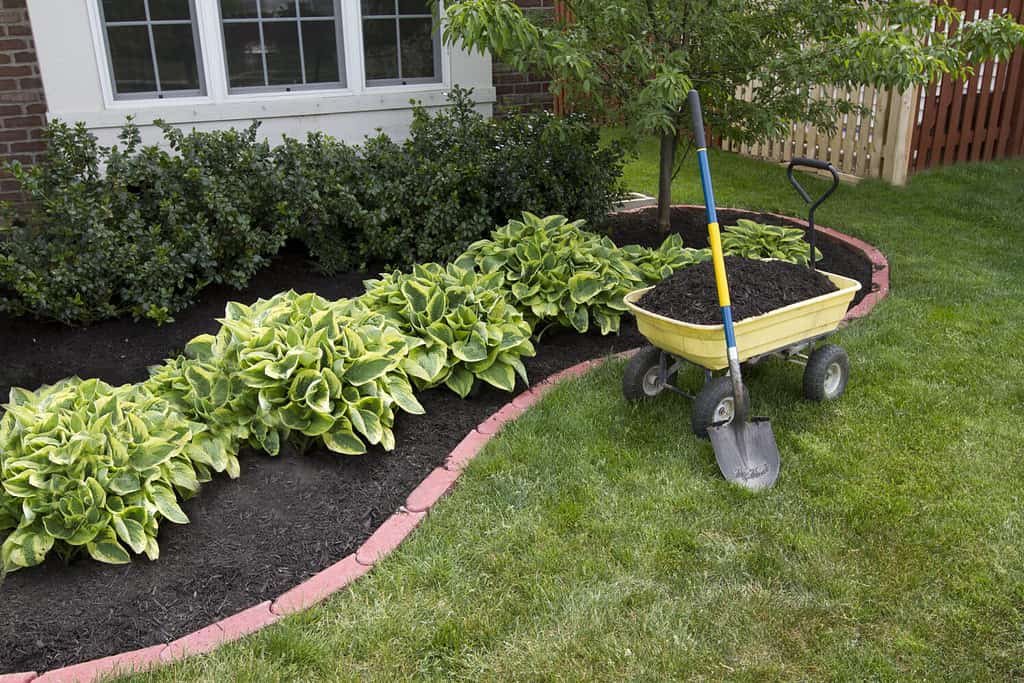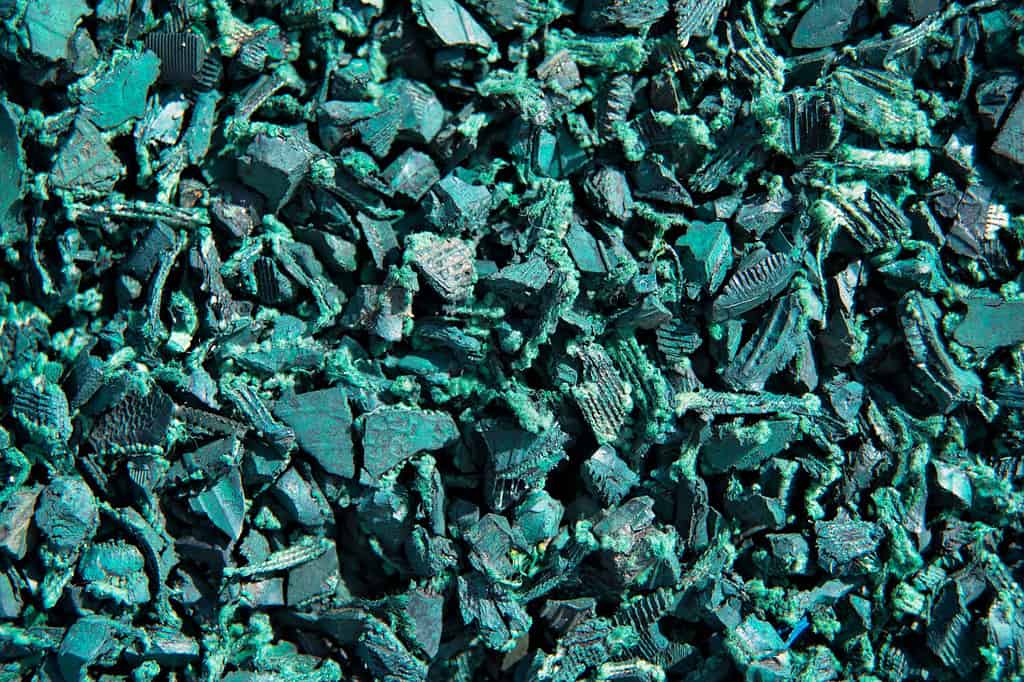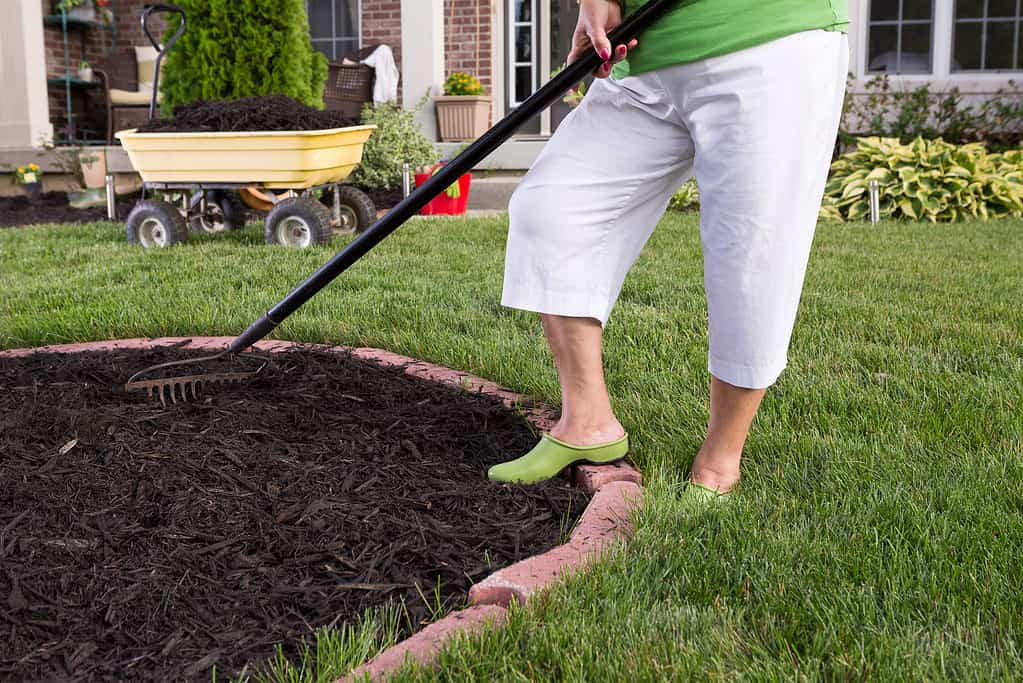Mulch is great for controlling weed growth, insulating bulbs during the winter, and retaining soil moisture during drought periods. However, not all options are created equal; some types last longer than others.
In this article, we’ll cover how long mulch lasts by type and the pros and cons of each option so you know which to choose for your garden.
Let’s dig in!
What Is Mulch?
When most people hear the term “mulch,” they picture wood chips. While this type is the most common, the word mulch refers to any covering used to cover the soil and provide a layer of protection. You can use anything from grass clippings to recycled rubber tires.
Choosing the best type of mulch for your garden depends on your intended purpose, climate, and aesthetic preferences.

Mulch adds a protective layer to insulate the soil and limit weed growth.
©Ozgur Coskun/Shutterstock.com
Types of Mulch
While there are several types of mulch available, they fall under two categories: organic and inorganic or synthetic.
Organic Mulch
Organic mulch is derived from natural materials, like wood chips, bark, leaves, grass clippings, or paper products.
The main benefit of organic mulch is that it will add nutrients to the soil as it breaks down. However, organic mulch must be replaced over time, adding to the cost and workload of maintaining your garden.
Inorganic or Synthetic Mulch
Inorganic or synthetic mulch is comprised of manufactured materials, such as recycled rubber or plastic sheeting. Stones and pebbles are also classified as inorganic mulch, even though they’re naturally occurring. This classification is due to the fact that they don’t decompose.
Many gardeners prefer inorganic materials to minimize the replacement timeline. However, certain materials (like rubber) can interfere with soil penetration during heavy rains and have limited positive environmental impacts.
Factors Impacting the Lifespan of Mulch
In addition to the type of mulch being used, there are several factors that could influence the overall lifespan.
- Rainfall levels – the higher the amount of rainfall in your area, the shorter the lifespan.
- Sun exposure – increased sun exposure will exacerbate the natural breakdown or cause the color to fade.
- Installation and maintenance – proper installation methods and regular maintenance will help increase the overall lifespan.
There’s no black-and-white answer on how long mulch will last; it’s entirely dependent on your climate, habits, and the unique qualities of your yard.

Rubber mulch has a longer lifespan than organic varieties.
©Kayla Blundell/Shutterstock.com
Average Lifespan of Wood Chips or Bark
Wood chips or bark can last anywhere from 2-7 years, depending on the type, climate, and aesthetic preferences.
Bark tends to outlast woodchips, lasting seven or more years in ideal conditions. This extended lifespan is due to the bark’s structure.
Consider the purpose of bark in nature: it provides a defensive outer shell on a tree to protect the more sensitive wood underneath. The same theory applies when using it for your garden.
While wood chips and bark may last structurally for years, you may choose to replace them sooner based on aesthetic preferences. The wood will start to fade and lose color within the first few seasons. If you prefer the bold red, black, or tan color in your garden, plan to replenish wood mulch within three years.
Average Lifespan of Straw or Hay
Straw is an affordable, organic mulch that provides a protective layer to the soil and encourages beneficial insects to set up shop in your garden.
The downside of straw mulch is that it typically only lasts for one growing season. However, it’s easy to remove and compost when the growing season is over.
Average Lifespan of Leaves
Leaf mulch is another affordable, organic option that many eco-conscious gardeners use to protect and nourish their gardens. This option is ideal for people in rural areas with plenty of trees in their yards or in warmer climates who can grow outdoors year-round.
Leaves typically last no more than one growing season. Apply a dense layer of leaves over your garden in the winter to protect bulbs and perennial plants. As the leaves break down, you can churn them into the soil for some nutrient-rich organic matter.
Average Lifespan of Newspaper
Newspaper is an excellent organic option for weed suppression in your garden. It typically lasts 2-3 months before breaking down into the soil, though this timeline is contingent on the type of ink and treatment used in the paper.
While glossy magazine pages may last longer, they can negatively alter the soil pH and potentially damage your garden. Use untreated pages whenever possible.
Average Lifespan of Grass Clippings
Grass clippings have one of the shortest lifespans, needing to be replenished several times throughout the growing season. However, this option is an eco-friendly option for dealing with grass cuttings and getting more out of your garden.
When using grass cuttings, remove old, matted-down cuttings before adding a fresh layer to maintain suitable drainage and avoid unpleasant odors.
Average Lifespan of Rubber Mulch
Rubber mulch can last up to ten years. It will not break down into the soil but may wash away or erode in the sunlight over time. In some climates, rubber mulch could last for decades.
Average Lifespan of Plastic Mulch
Plastic mulch can last anywhere from 2-10 years, depending on the local climate and the type of plastic. Alternatively, plastic sheeting can be reused season after season unless it becomes damaged.
Plastic mulch is the subject of much controversy and is banned in some areas. Be sure to do your research when exploring this option, and consider something more eco-friendly.
Average Lifespan of Stone Mulch
Stone mulch can last anywhere from 5-10 years in ideal conditions. The overall lifespan is contingent on the local climate and aesthetic preferences.
For example, if you live in a rainy area, the stones will likely wash away over time. Additionally, the color will fade in the sun. If you like the bright pop of color your new stone mulch offers, you may choose to top it up more frequently than necessary.
Average Lifespan of Landscape Fabric
Landscape fabric will last 2-3 growing seasons, depending on the type of fabric used. Organic blends will typically have a shorter lifespan than brands with synthetic materials added.
How to Extend the Lifespan of Mulch
There are several things you can do to extend the lifespan of mulch in your garden.
- Choose the right type – do your research to determine what type of mulch is best for your yard and goals. Inorganic tends to last longer than organic.
- Install properly – add a thick layer of mulch, researching the ideal depth based on the type you’ve chosen. Ideally, you’ll add at least 3-5 inches.
- Weed regularly – mulch can help with weed suppression, but it’s not 100% effective. Maintain and weed your garden regularly to get more from your mulch.
- Use edging – edging your gardens will help prevent erosion and keep your mulch in place.
- Replenish over time – replenishing a bit of mulch every season will help maintain levels and prevent exponential breakdown over time.
Research maintenance and upkeep recommendations based on the type of mulch you choose for best results.

Edging your gardens can help prevent erosion.
©iStock.com/ozgurcoskun
Can I Reuse Old Mulch?
If the mulch still has structure and is free of any signs of pests or odors, you can reuse it. However, if it’s broken down or has a strong smell of rot, discard it away from your garden.
How Do I Prevent Mulch From Fading?
Keep your mulch looking fresh by proactively weeding and churning the mulch regularly. You can also get mulch dye to renew the color. However, it’s important to choose a natural dye to avoid adding toxins to your local eco-system.
Thank you for reading! Have some feedback for us? Contact the AZ Animals editorial team.








